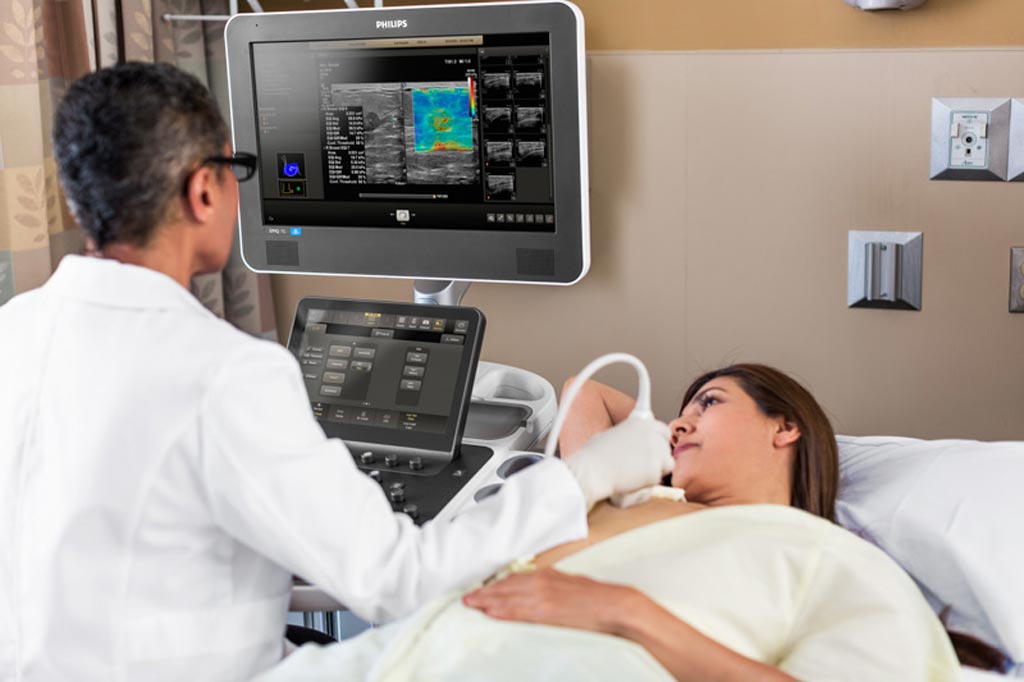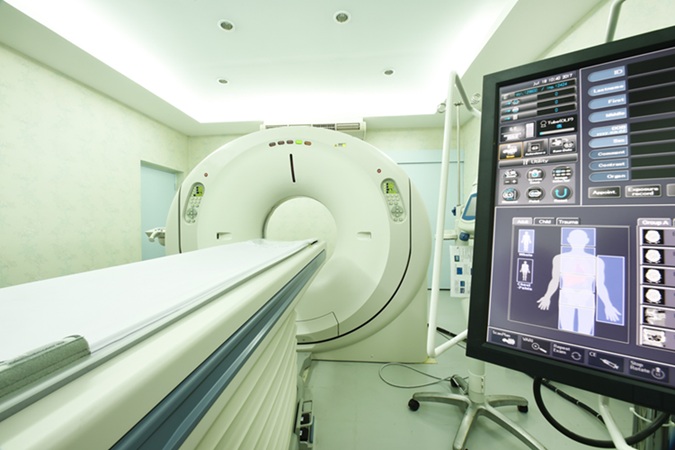Global Automated Breast Ultrasound Systems Market to Surpass USD 1.8 Billion by 2025
|
By MedImaging International staff writers Posted on 07 Nov 2019 |

Image: The global automated breast ultrasound systems (ABUS) market is being driven by increasing government expenditure and rising awareness about breast cancer (Photo courtesy of Philips Healthcare).
The global automated breast ultrasound systems (ABUS) market was valued at over USD 0.68 billion in 2018 and is projected to grow at a CAGR 16.1% during the forecast period, 2019-2025 to surpass USD 1.8 billion by 2025, driven by increasing government expenditure and rising awareness about breast cancer. Initiatives such as free check-up camps and symposiums for raising awareness regarding early detection and diagnosis of breast cancer will lead to greater adoption of ABUS in the coming years. However, stringent regulations and guidelines for the approval of ABUS, coupled with the high cost of diagnostic procedure, could hamper the market growth during the forecast period.
These are the latest findings of Global Market Insights, Inc. (Selbyville, DE, USA; www.gminsights.com), a global market research and management consulting company.
ABUS is superior than conventional technologies in the detection of consistent breast lesion growth. ABUS assists during critical processes for identification and characterization of breast lesions, leading to reduced treatment costs. Moreover, ABUS provide precise anatomical images for breast cancer diagnosis, thereby majorly impacting operational and diagnostic efficiency. Increasing advancements in ABUS for accurate diagnosis and timely treatment will increase the adoption of breast ultrasound systems over the coming years.
High breast tissue density, lower childbearing and hormonal imbalance issues among women due to changing lifestyle are the major risk factors for breast cancer, thus providing lucrative opportunities for the growth of the global ABUS market. According to the World Health Organization, approximately 2.1 million patients suffer from breast cancer each year. The rising prevalence of breast cancer globally will generate significant demand for ABUS over the forecast period.
In 2018, the diagnostic imaging centers segment reported revenues of USD 0.65 billion. The adoption of ABUS in diagnostic imaging centers is estimated to witness rapid growth due to the expansion of early diagnosis and detection of cancerous cells in the body. The growing availability of specialized technology-based breast imaging techniques and cutting-edge imaging technologies in diagnostic facilities will augment the growth of the diagnostic imaging centers segment. Furthermore, the increasing number of facilities and healthcare infrastructure in the emerging countries will drive the segmental growth during the forecast period.
Geographically, the US held a share of more than 89.0% in the global ABUS market in 2018. The growing adoption of ABUS for the early detection of breast cancer, coupled with the implementation of government initiatives such as Pink Initiative, funding as well as increased awareness will act as the key drivers of the market growth in the US. Furthermore, the presence of established market players in the US will contribute significantly to the growth of the country’s ABUS market during the forecast period.
The ABUS market in Saudi Arabia is projected to grow at a lucrative CAGR of 20.1% during the forecast period, driven by rapidly emerging cancer diagnosis and treatment in the country. Increasing hospitals and government expenditure offering cost advantages are driving the adoption rate of ABUS in Saudi Arabia. Moreover, an increasing patient pool along with growing research activities for innovating ABUS will further aid the growth of the ABUS market in Saudi Arabia.
Related Links:
Global Market Insights, Inc.
These are the latest findings of Global Market Insights, Inc. (Selbyville, DE, USA; www.gminsights.com), a global market research and management consulting company.
ABUS is superior than conventional technologies in the detection of consistent breast lesion growth. ABUS assists during critical processes for identification and characterization of breast lesions, leading to reduced treatment costs. Moreover, ABUS provide precise anatomical images for breast cancer diagnosis, thereby majorly impacting operational and diagnostic efficiency. Increasing advancements in ABUS for accurate diagnosis and timely treatment will increase the adoption of breast ultrasound systems over the coming years.
High breast tissue density, lower childbearing and hormonal imbalance issues among women due to changing lifestyle are the major risk factors for breast cancer, thus providing lucrative opportunities for the growth of the global ABUS market. According to the World Health Organization, approximately 2.1 million patients suffer from breast cancer each year. The rising prevalence of breast cancer globally will generate significant demand for ABUS over the forecast period.
In 2018, the diagnostic imaging centers segment reported revenues of USD 0.65 billion. The adoption of ABUS in diagnostic imaging centers is estimated to witness rapid growth due to the expansion of early diagnosis and detection of cancerous cells in the body. The growing availability of specialized technology-based breast imaging techniques and cutting-edge imaging technologies in diagnostic facilities will augment the growth of the diagnostic imaging centers segment. Furthermore, the increasing number of facilities and healthcare infrastructure in the emerging countries will drive the segmental growth during the forecast period.
Geographically, the US held a share of more than 89.0% in the global ABUS market in 2018. The growing adoption of ABUS for the early detection of breast cancer, coupled with the implementation of government initiatives such as Pink Initiative, funding as well as increased awareness will act as the key drivers of the market growth in the US. Furthermore, the presence of established market players in the US will contribute significantly to the growth of the country’s ABUS market during the forecast period.
The ABUS market in Saudi Arabia is projected to grow at a lucrative CAGR of 20.1% during the forecast period, driven by rapidly emerging cancer diagnosis and treatment in the country. Increasing hospitals and government expenditure offering cost advantages are driving the adoption rate of ABUS in Saudi Arabia. Moreover, an increasing patient pool along with growing research activities for innovating ABUS will further aid the growth of the ABUS market in Saudi Arabia.
Related Links:
Global Market Insights, Inc.
Latest Industry News News
- GE HealthCare and NVIDIA Collaboration to Reimagine Diagnostic Imaging
- Patient-Specific 3D-Printed Phantoms Transform CT Imaging
- Siemens and Sectra Collaborate on Enhancing Radiology Workflows
- Bracco Diagnostics and ColoWatch Partner to Expand Availability CRC Screening Tests Using Virtual Colonoscopy
- Mindray Partners with TeleRay to Streamline Ultrasound Delivery
- Philips and Medtronic Partner on Stroke Care
- Siemens and Medtronic Enter into Global Partnership for Advancing Spine Care Imaging Technologies
- RSNA 2024 Technical Exhibits to Showcase Latest Advances in Radiology
- Bracco Collaborates with Arrayus on Microbubble-Assisted Focused Ultrasound Therapy for Pancreatic Cancer
- Innovative Collaboration to Enhance Ischemic Stroke Detection and Elevate Standards in Diagnostic Imaging
- RSNA 2024 Registration Opens
- Microsoft collaborates with Leading Academic Medical Systems to Advance AI in Medical Imaging
- GE HealthCare Acquires Intelligent Ultrasound Group’s Clinical Artificial Intelligence Business
- Bayer and Rad AI Collaborate on Expanding Use of Cutting Edge AI Radiology Operational Solutions
- Polish Med-Tech Company BrainScan to Expand Extensively into Foreign Markets
- Hologic Acquires UK-Based Breast Surgical Guidance Company Endomagnetics Ltd.
Channels
Radiography
view channel
World's Largest Class Single Crystal Diamond Radiation Detector Opens New Possibilities for Diagnostic Imaging
Diamonds possess ideal physical properties for radiation detection, such as exceptional thermal and chemical stability along with a quick response time. Made of carbon with an atomic number of six, diamonds... Read more
AI-Powered Imaging Technique Shows Promise in Evaluating Patients for PCI
Percutaneous coronary intervention (PCI), also known as coronary angioplasty, is a minimally invasive procedure where small metal tubes called stents are inserted into partially blocked coronary arteries... Read moreMRI
view channel
AI Tool Tracks Effectiveness of Multiple Sclerosis Treatments Using Brain MRI Scans
Multiple sclerosis (MS) is a condition in which the immune system attacks the brain and spinal cord, leading to impairments in movement, sensation, and cognition. Magnetic Resonance Imaging (MRI) markers... Read more
Ultra-Powerful MRI Scans Enable Life-Changing Surgery in Treatment-Resistant Epileptic Patients
Approximately 360,000 individuals in the UK suffer from focal epilepsy, a condition in which seizures spread from one part of the brain. Around a third of these patients experience persistent seizures... Read more
AI-Powered MRI Technology Improves Parkinson’s Diagnoses
Current research shows that the accuracy of diagnosing Parkinson’s disease typically ranges from 55% to 78% within the first five years of assessment. This is partly due to the similarities shared by Parkinson’s... Read more
Biparametric MRI Combined with AI Enhances Detection of Clinically Significant Prostate Cancer
Artificial intelligence (AI) technologies are transforming the way medical images are analyzed, offering unprecedented capabilities in quantitatively extracting features that go beyond traditional visual... Read moreUltrasound
view channel.jpeg)
AI-Powered Lung Ultrasound Outperforms Human Experts in Tuberculosis Diagnosis
Despite global declines in tuberculosis (TB) rates in previous years, the incidence of TB rose by 4.6% from 2020 to 2023. Early screening and rapid diagnosis are essential elements of the World Health... Read more
AI Identifies Heart Valve Disease from Common Imaging Test
Tricuspid regurgitation is a condition where the heart's tricuspid valve does not close completely during contraction, leading to backward blood flow, which can result in heart failure. A new artificial... Read moreNuclear Medicine
view channel
Novel Radiolabeled Antibody Improves Diagnosis and Treatment of Solid Tumors
Interleukin-13 receptor α-2 (IL13Rα2) is a cell surface receptor commonly found in solid tumors such as glioblastoma, melanoma, and breast cancer. It is minimally expressed in normal tissues, making it... Read more
Novel PET Imaging Approach Offers Never-Before-Seen View of Neuroinflammation
COX-2, an enzyme that plays a key role in brain inflammation, can be significantly upregulated by inflammatory stimuli and neuroexcitation. Researchers suggest that COX-2 density in the brain could serve... Read moreGeneral/Advanced Imaging
view channel
AI-Powered Imaging System Improves Lung Cancer Diagnosis
Given the need to detect lung cancer at earlier stages, there is an increasing need for a definitive diagnostic pathway for patients with suspicious pulmonary nodules. However, obtaining tissue samples... Read more
AI Model Significantly Enhances Low-Dose CT Capabilities
Lung cancer remains one of the most challenging diseases, making early diagnosis vital for effective treatment. Fortunately, advancements in artificial intelligence (AI) are revolutionizing lung cancer... Read moreImaging IT
view channel
New Google Cloud Medical Imaging Suite Makes Imaging Healthcare Data More Accessible
Medical imaging is a critical tool used to diagnose patients, and there are billions of medical images scanned globally each year. Imaging data accounts for about 90% of all healthcare data1 and, until... Read more





















